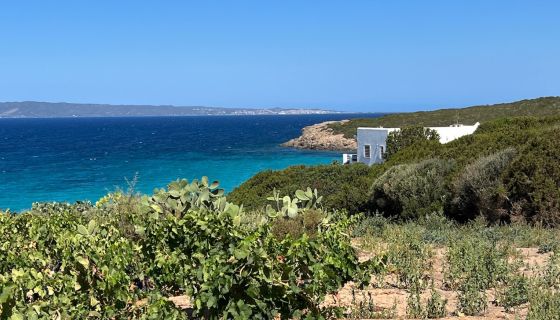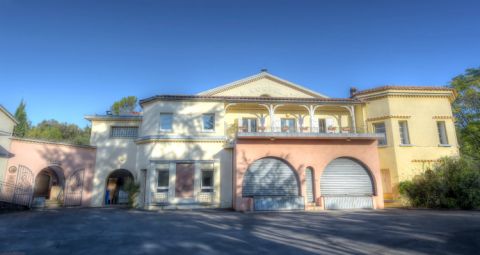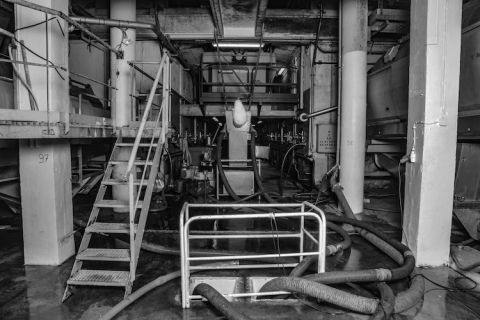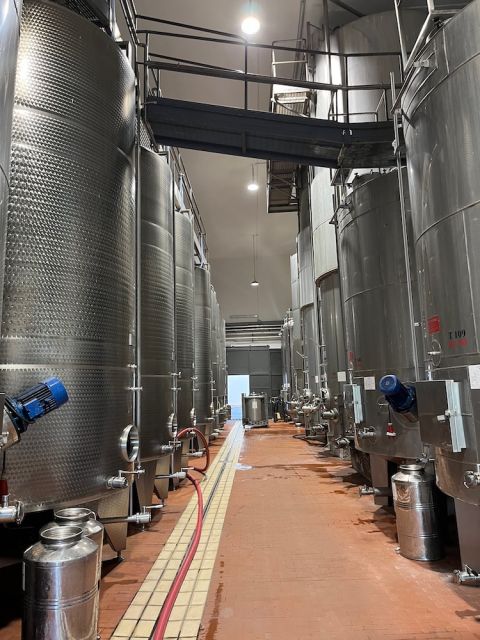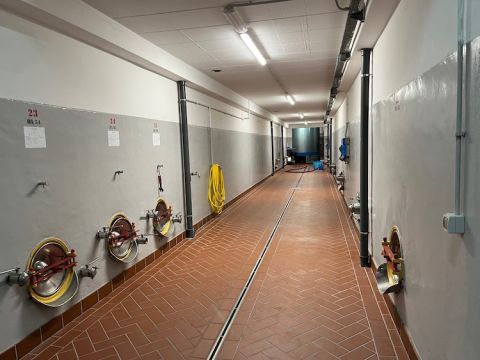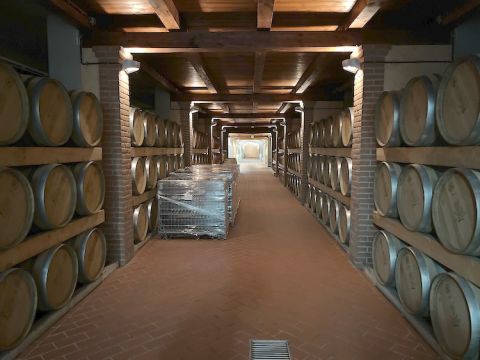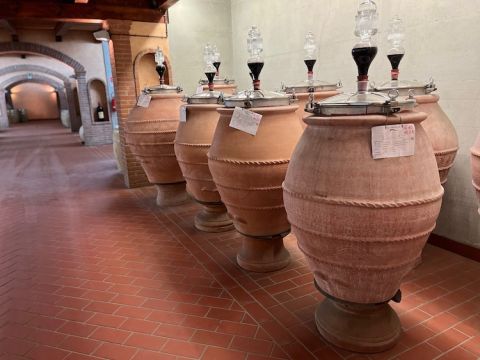Stone Vine & Sun is a hard-working independent wine merchant based in Hampshire with a particular interest in the Languedoc, source of so many great-value wines. At their tasting in London in May I came across a white based on the vibrant local Clairette grape that seemed a steal. It still does even though, like most wines, it has gone up in price, from £10.95 to £11.50 in this case.
I wanted to order some for our summer in the Languedoc and contacted the producer, the L’Estabel co-op in the little village, and appellation, of Cabrières. Luc Flache, who turns out to be both director and winemaker, was extremely responsive and I decided to pay him a visit in late July, encouraged by the fact that France’s annual wine bible, the Guide Hachette, had made L’Estabel a Vigneron de l’Année in the most recent edition. The first time a co-op, pictured below, had been so honoured, Flache told me with pride in their little wine shop.
I tasted a range of their wines, including a no-added-sulphites red cleverly named On Souf(f)re Pas that Flache had devised, and was impressed. When I asked to see the winery I was led in via a crowded office, with the door to the winery left open so that Flache and his colleague could benefit from the air conditioning installed in the winery 20 years ago.
Once inside the winery I’m afraid to say I was mildly appalled. Air con apart, it looked as though little had changed since it was built in 1937. It was dark. The concrete vats were grey with age. There was an apparently random tangle of pipes on the floor. It reminded me of one or two Bulgarian wineries I visited in the 1980s before EU money had been poured in to spruce them up. I felt certain that neither the buying team of Stone Vine & Sun nor the editor of the Guide Hachette had visited L’Estabel and I was right. The photo below was not taken by me; it was officially supplied by the co-op.
Spending my summers in the Languedoc, I know there are wine co-ops just like this all over the region, receptacles for the produce of their members who don’t have the expertise, equipment or will to make wine for themselves. They make the sort of very ordinary wine that the French government recently promised to spend €200 million distilling into industrial alcohol since it is surplus to requirements in today’s shrinking and increasingly discriminating market.
But Flache has somehow managed to make some really good wines – and has increased the proportion of organic wine produced from 1% to 30% in his seven-year tenure – with some extremely basic equipment. The answer, to coin a phrase some older readers may remember from the radio programme Beyond Our Ken, must lie in the soil.
Cabrières, due west of Montpellier and surrounded by mountains, has a strange geology in which layers of limestone and the same sort of schist as adds nerve to many wines from its neighbours Faugères and St-Chinian are unusually positioned. The area, with no more than 300 ha (740 acres) of vines, must have something going for it because the king of Languedoc wine production Gérard Bertrand makes a rosé here, Clos du Temple, for which he asks more than £100 a bottle. And Tony Laithwaite, king of DTC wine retailing, is also about to buy a vineyard in Cabrières. L'Estabel already supply Laithwaites with white and rosé under the label Le Roi Soleil. Cabrières wine is locally supposed to have been loved by The Sun King Louis XIV.
Ten days later I visited the Santadi wine co-op in southern Sardinia and couldn’t believe the contrast. Here one could actually eat off the floor; see below.
Admittedly Santadi produces about twice as much wine as L’Estabel, about three million litres (nearly 800,000 gallons) a year, but here everything was gleaming. I certainly wouldn’t measure quality in terms of the number of oak casks but at L’Estabel there were 20 of varying ages. At Santadi there are 3,000 French barriques in their glamorous barrel hall and they renew about 20% of them each year. Since 2019, in line with current winemaking fashion, they have also been experimenting with ageing wine in terracotta pots imported from Tuscany.
I was taken on a tour of their many spotless winery buildings, including the spanking new one including a conference centre, inaugurated in 2018 with Tuscany’s most famous wine producer Piero Antinori in attendance. All was sweet-smelling. ‘We clean the cellar daily. It’s a maniacal situation for us’, the commercial manager Massimo Podda told me.
So how come Santadi seems to be so much more sophisticated? Partly it is down to the vision of the chairman Antonello Pilloni who has been in post ever since 1976. In 1980 he decided he’d had enough of simply providing usefully potent, deep-coloured blending wine in bulk for the likes of Antinori on the mainland. He persuaded Antinori’s famous oenologist Giacomo Tachis to come and advise them on how they could make fine wines to be sold in bottle at a much higher price. The result, from 1984, was the barrique-aged Terre Brune and subsequently, to ensure only the very best and longest-living wine went into it, a sister wine Rocca Rubia – both of them made from the Carignan vines that thrive here in sandy soils by the emerald sea (see main image above). Carignano del Sulcis reaches heights that I find very few other Carignans do. Today Santadi make a range of excellent wines of all three colours, and claim to pay more for their grapes than any Italian wine co-op other than the best in subalpine Trentino-Alto Adige.
They have a winemaker, an agronomist, and each of their 220 grape growers can access an app devised in conjunction with the University of Turin that advises them on the state of their vines. So how can they afford all this?
There’s a clue on the home page of Santadi’s website in a box which says ‘Campaign financed in accordance with EU regulation No 1308/13’. As a wild generalisation, Italian wine producers are past masters at navigating bureaucracy towards a pot of useful money. The statistics for EU spend on supporting the wine industries of its members show Italy way out in front, having received nearly five billion euros from Brussels since 2009. They have had the lion’s share of the budget available to promote wine outside the EU but the biggest share has been spent on what is called restructuring.
Podda explained as we toured his beautiful wine country, ‘yes, we get EU funds via the regional government to grow the cellar and buy new equipment. For us it’s normal to try to participate in what’s available.’
Luc Flache of L’Estabel says he applies for public funds to renovate the winery every year. Perhaps he should get some tips from Santadi.
See also Walter’s recent tale of how Sardinia’s leading private wine producer Sella & Mosca harnessed the magic of the barrique as early as 1982.
Superior co-operative wines
L'Estabel
Whites
Grande Cuvée Comtesse 2022 Languedoc 13%
£11.50 Stone Vine & Sun
Fulcrand Cabanon 2022 Clairette du Languedoc 13%
€39.50 per case of 6 producer's website
Le Grand Pan 2022 Clairette du Languedoc, Cabrières 13.5%
€49.50 per case of 6 producer's website
Rosé
Le Grand Pan Rosé 2022 Languedoc, Cabrières 13%
€39.60 per case of 6 producer's website
Red
Cantate des Garrigues 2021 Languedoc, Cabrières 14%
€57.50 per case of 6 producer's website
Santadi
White
Pedraia 2021 Nuragus di Cagliari 13.5%
£14.95 The Great Wine Co
Red
Antigua 2021 Monica di Sardegna 13.5%
From €8.89 in many European markets – a steal
Noras 2020 Cannonau di Sardegna 15%
£16.85 Xtra Wine and other UK merchants; $27.60 Saratoga Wine Exchange, NY
Rocca Rubia 2020 Riserva Carignano del Sulcis 14.5%
£21.90 VINVM; $27.98 B-21, FL
Shardana 2019 IGT Valli di Porto Pino 14.5%
29 Swiss francs Liechti Weine and Bottega Alimentare
Terre Brune 2019 Superiore Carignano del Sulcis 15%
£52.95 AG Wines and other UK merchants
For tasting notes, scores and suggested drink dates see Co-operative Clairette and Carignan. For more international stockists see Wine-Searcher.com.

